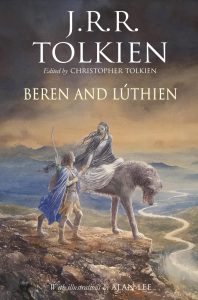 A compilation of Tolkien’s tales of Beren and Lúthien will be published on 1 June 2017, HarperCollins has announced.
A compilation of Tolkien’s tales of Beren and Lúthien will be published on 1 June 2017, HarperCollins has announced.
Edited by Christopher Tolkien and illustrated by Alan Lee, Beren and Lúthien will bring together material scattered throughout the 12-volume History of Middle-earth series.
The earliest version of the tale of Beren and Lúthien was written in 1917, when Beren was an Elf not a Man and the equivalent of Sauron was a large evil cat.
The story underwent considerable revision throughout Tolkien’s life, and was reworked in both prose and poetry. The new book will demonstrate this evolution.
Beren and Lúthien will be published 100 years since Tolkien’s wife Edith danced for him in a small woodland glade filled with hemlocks in East Yorkshire, an event he later acknowledged was the inspiration for the meeting of the immortal Lúthien Tinúviel and the mortal Beren in the glades beside Esgalduin.
J.R.R. Tolkien’s Beren and Lúthien will be published on 1 June 2017.
From the publisher
Painstakingly restored from Tolkien’s manuscripts and presented for the first time as a fully continuous and standalone story, the epic tale of Beren and Lúthien will reunite fans of The Hobbit and The Lord of the Rings with Elves and Men, Dwarves and Orcs and the rich landscape and creatures unique to Tolkien’s Middle-earth.
The tale of Beren and Lúthien was, or became, an essential element in the evolution of The Silmarillion, the myths and legends of the First Age of the World conceived by J.R.R. Tolkien. Returning from France and the battle of the Somme at the end of 1916, he wrote the tale in the following year.
Essential to the story, and never changed, is the fate that shadowed the love of Beren and Lúthien: for Beren was a mortal man, but Lúthien was an immortal Elf. Her father, a great Elvish lord, in deep opposition to Beren, imposed on him an impossible task that he must perform before he might wed Lúthien. This is the kernel of the legend; and it leads to the supremely heroic attempt of Beren and Lúthien together to rob the greatest of all evil beings, Melkor, called Morgoth, the Black Enemy, of a Silmaril.
In this book Christopher Tolkien has attempted to extract the story of Beren and Lúthien from the comprehensive work in which it was embedded; but that story was itself changing as it developed new associations within the larger history. To show something of the process whereby this legend of Middle-earth evolved over the years, he has told the story in his father’s own words by giving, first, its original form, and then passages in prose and verse from later texts that illustrate the narrative as it changed. Presented together for the first time, they reveal aspects of the story, both in event and in narrative immediacy, that were afterwards lost.